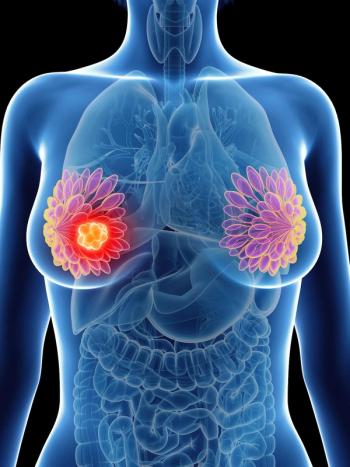
Oncology NEWS International
- Oncology NEWS International Vol 13 No 9
- Volume 13
- Issue 9
Older Breast Cancer Patients Can Forgo Axillary Clearance Without Compromising Survival: Results of IBCSG 10-93
NEW ORLEANS-The first results from a large international study presented at the 40th Annual Meeting of the American Society of Clinical Oncology (abstract 505) show that older node-negative breast cancer patients can avoid axillary clearance and have survival outcomes similar to those of women who undergo the invasive procedure. Stig Holmberg, MD, of Gothenberg, Sweden, principal investigator for the International Breast Cancer Study Group (IBCSG) Trial 10-93, said the study was performed to determine if sparing women the trauma and side effects associated with axillary clearance would improve their quality of life without compromising survival.
NEW ORLEANSThe first results from a large international study presented at the 40th Annual Meeting of the American Society of Clinical Oncology (abstract 505) show that older node-negative breast cancer patients can avoid axillary clearance and have survival outcomes similar to those of women who undergo the invasive procedure. Stig Holmberg, MD, of Gothenberg, Sweden, principal investigator for the International Breast Cancer Study Group (IBCSG) Trial 10-93, said the study was performed to determine if sparing women the trauma and side effects associated with axillary clearance would improve their quality of life without compromising survival.
473 Patients Randomized
In the study, performed from 1993 to 2002, 473 women aged 60 and older (median age, 74), three fourths with clinically node-negative breast cancer, were randomized to receive breast surgery with axillary clearance or surgery without axillary clearance. Both groups received tamoxifen for 5 years. The median follow-up was 6 years.
The groups were well matched and had the following characteristics: 80% estrogen-receptor positive, 45% mastectomy, 33% breast-conserving surgery with radiotherapy; and 23% breast-conserving surgery without radiotherapy. Among the patients who had axillary clearance, 27% were found to have node-positive disease.
The primary endpoint was quality of life by patient assessment, using linear analogue self-assessment (LASA) scales, and by physician assessment at sequential time points.
Secondary endpoints were rates of axillary recurrence, disease-free and overall survival, and sites of first event. The study was not designed to show equivalency between the arms in terms of disease-free and overall survival. Patients were assessed at baseline, after surgery, and at months 3, 4, 9, 12, 18, and 24.
By both patient-reported and physician-reported measures, side effects were significantly increased and quality of life was poorer for patients having axillary clearance, but this was mainly limited to the postoperative period, Dr. Holmberg reported.
In the postoperative period, restricted arm movement was noted in 38% of the axillary clearance patients, compared with 15% with surgery alone (P = .00001). "However, after the postop period, the percentage in either group was similar and approached preoperative values," he said. Physicians reported arm pain in 23% of the axillary clearance group, compared with 7% with surgery alone (P = .0001), but the differences were not significant at later time points. In general, any side effects resolved and approached baseline values in either group by 6 to 12 months.
Patient-reported quality-of-life measures included factors that gauged how much they were bothered by problems with their arms, shoulders, hands, and chest, and a global measure that asked how much effort it takes to cope with their condition. Patients in the surgery/axillary clearance group reported significantly more bother than those receiving surgery alone; however, these measurements returned to baseline over time. There were no differences in global measures at any points in times.
The axillary recurrence rates were similar between the groups: 1% with axillary clearance and 3% with surgery alone. "The incidence was low in this clinically node-negative population getting adjuvant tamoxifen," Dr. Holmberg noted.
Disease-free survival and overall survival rates were similar in both groups, although the study was not powered to show equivalency, Dr. Holmberg pointed out (see Figure). At 6 years, disease-free survival was 67% for surgery/axillary clearance vs 65% for surgery alone, and 6-year overall survival was 75% vs 73%, respectively.
Sites of first recurrence were also similar between the arms, he said. Altogether, 17% of patients had a breast-cancer-related occurrence and 21% had a non-breast-cancer second primary or death without recurrence.
"We concluded that avoiding axillary clearance in older, clinically node-negative patients being treated with tamoxifen improved quality of life, with no apparent compromise in disease-free survival, overall survival, or axillary recurrence," Dr. Holmberg said.
Articles in this issue
Newsletter
Stay up to date on recent advances in the multidisciplinary approach to cancer.

















































































